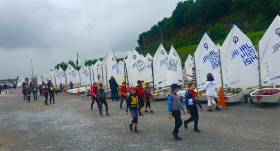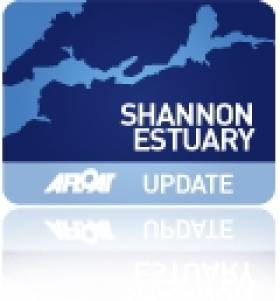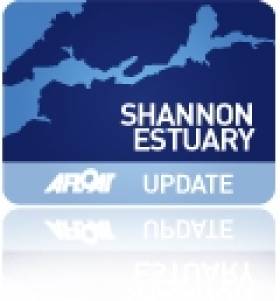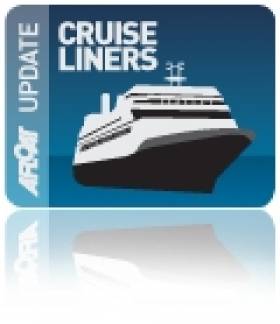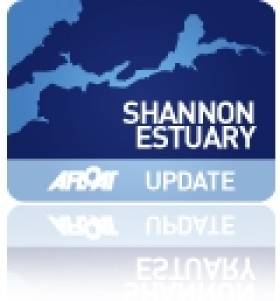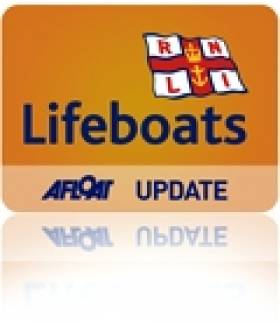Displaying items by tag: Foynes
Can Ger Owens Make It Three-In-A-Row Defending National Overall Helm Title In Mermaids At Foynes This Weekend?
It’s not the first time that the organisers of the National Championships of Champions have found themselves playing footsie with volatile Autumn weather.
Ten days ago, the National Junior Championship at Schull was cancelled due to southerly gales. And last year, the GP 14s’ representative Ger Owens found himself and his crew Mel Morris, retaining the trophy in an extremely intense one-day programme at Sutton Dinghy Club, as it was abundantly clear that any attempt at a second day of racing would be blown clean away.
Thus, meteorological fingers are crossed for this coming weekend (7th – 8th October), when the famously hospitable Foynes Yacht Club on the Shannon Estuary are staging the event in 17ft Mermaids. The Mermaids first appeared in 1932, and have been a significant presence in Irish sailing since 1936, so it isn’t the first time they’ve been used as the championship boat. For we happen to know for certain that in the 1965 Championship at Skerries in Mermaids, the winner was one James Nixon of Dublin University SC, and doubtless other sailing clans can make similar claims.
 An immaculately-prepared Mermaid from the Foynes fleet racing in the Shannon Estuary. Photo: Tony Quinlivan
An immaculately-prepared Mermaid from the Foynes fleet racing in the Shannon Estuary. Photo: Tony Quinlivan
But few of them can claim that their man or woman was going at it to make it three in a row, so it will be very interesting indeed to see how Owens shapes up out of his current comfort zone of the GP 14s. Experience suggests that he is multi-talented in the helming front. Meanwhile, those who are concerned about delays while the weather makes its mind up can be consoled by the fact that the sailors can otherwise occupy themselves with the flight simulator at the Foynes Flying Boat Museum near the club. Your correspondent once had a go at it, and managed to crash the Boeing 314 Clipper before he’d got beyond the simulated Loop Head.
Entry List 2023:
ILCA 7 Finn Lynch National YC Paris Olympic qualification place for Ireland
 All Ireland Sailing - 2023 Entry List
All Ireland Sailing - 2023 Entry List
Shannon Foynes Port’s Record Investment is a Step in Transforming Estuary into Floating Offshore Wind Generation Hub
A record €28million investment in jetty infrastructure and a port logistics park has been announced by Shannon Foynes Port Company today in a significant step in transitioning the Shannon Estuary into a major international renewable energy supply-chain hub.
The unprecedented investment, which is fully and co-funded by Shannon Foynes Port Company and the EU’s ‘Connecting Europe Facility, will include a significant expansion of quayside area through the joining and infilling of two existing jetties. This will deliver an additional 117m of jetty set down/storage area by linking the existing east and west jetties at the port, substantially boosting existing quayside set down space.
Also included in the investment programme is the development of one of the country’s largest logistics buildings in a significant boost to national bulk and unitized freight supply chain infrastructure. The 127,000 sq ft facility will be the key element in a new 38 hectares port logistics park that will have the potential for a future 400,000 sq ft of modern logistics warehousing over the coming decade and a half.
Planning permission and foreshore consents for the developments, which amount to the largest ever financial commitment in civil works by the port company, have been secured, with work already underway on the new jetty and associated set down area following construction procurement.
Work on the logistics park, which will become the largest building at the Tier 1 international port, will commence in Q3 of this year, with all works completed in the first half of 2024.
The Connecting Europe Facility (CEF), which is co-funding the project, is a key EU funding instrument to promote growth, jobs and competitiveness through targeted infrastructure investment at European level. It supports the development of high performing, sustainable and efficiently interconnected trans-European networks in the fields of transport, energy and digital services. CEF investments fill the missing links in Europe's energy, transport and digital backbone.
Shannon Foynes Port Company Chief Executive Pat Keating said: “This investment reflects the unprecedented opportunity for the Shannon Estuary and Shannon Foynes Port Company. It represents the next stage of implementation of our investment programme and, importantly, lays the foundation for further required scalable capacity investments to accommodate growth in both the offshore renewable sector and the transport sector. For example, our objective to be the supply chain facilitator for an Atlantic floating offshore wind energy hub and related hydrogen production will be transformational in terms of our climate action targets, our national economy and energy security.
“We have some of the most consistent winds in the world off the west coast, the technology now in place to harness those winds through floating offshore wind and, in the Shannon Estuary, the deep and sheltered waters necessary to build the floating devices before they are brought out into open ocean waters. The world’s leading players in this space want to invest here and leading nations, such as Germany, want the green hydrogen we can generate from this almost limitless renewable energy. But for all this to happen, we need to invest heavily in our infrastructure and the plans we are announcing today are significant step in that regard.”
Shannon Foynes Port Company’s Offshore Floating Wind Study conservatively estimates that up to €12bn in associated supply chain investment could be located on the Shannon Estuary by 2050, with an opportunity to create up to 30,000 jobs.
Speaking on the significant investment in logistics, John Carlton, Engineering and Port Services Manager at Shannon Foynes Port Company said, “Our new logistics park will be a game-changer for bulk and containerised goods in Ireland. There is unanimity around the need to counterbalance and build resilience in the national supply chain and, in keeping with the National Development Plan, a key facilitator of this is to promote regional development by optimising capacity outside the congested east coast. Developing modern logistics facilities at the deep-water port of Foynes provides new logistics solutions for the western half of the country, offering more efficient and sustainable market access for importers and exporters alike by reducing the ton per kilometre travelled.”
Shannon Foynes Port Company Chairman David McGarry added: “When we launched our Vision 2041 masterplan in 2013, it was seen as a hugely ambitious strategy, yet we have reached its growth targets. The record investment we are announcing today, which is our biggest single commitment yet, is the latest but a key element of that masterplan.”
The National YC's Dun Laoghaire to Dingle Race of Wednesday, June 9th – just two days after such things became permissible on June 7th - may have been hailed here as "a spectacular pillar event to launch the 2021 Irish sailing season out of the pandemic penumbra". But the truth is that the season currently getting under way is more like a gentle tide flooding into a winding and shallow creek, rather than a sudden eruption of activity across a wide front.
As with the new tide, if you watch closely and persistently for things happening, you'll see little change. But if your focus switches elsewhere for a while, then look back again and you'll find real signs of things starting to happen, of development taking place and sailing centres coming more vibrantly to life with events which are in themselves a testing of the waters.
This sense of testing of the waters reflects a commendable maturity in the sailing community. Our sport manifests itself in so many ways afloat and ashore that it is simply impossible to devise rules about distancing and so forth which comply precisely with each and every requirement. Thus as each event takes shape, a substantial input of common sense is required to ensure that it optimizes the sport while minimising any infection hazard.
 When the going gets tough….overall winner Nieulargo (Denis Murphy RCYC, left) and Pete Smyth's Sun Fast 3600 Searcher (NYC) getting their teeth into the early stages of the Dun Laoghaire to Dingle Race. Photo: Michael Chester
When the going gets tough….overall winner Nieulargo (Denis Murphy RCYC, left) and Pete Smyth's Sun Fast 3600 Searcher (NYC) getting their teeth into the early stages of the Dun Laoghaire to Dingle Race. Photo: Michael Chester
Of course we can claim that the hazard is decreasing on a daily basis. But no sooner is this assumed that some new twist arises, and having shared the battle for so long, it would be at odds with the remarkable overall cohesiveness of Irish society to flaunt the rules with blatant disregard, even if some very small sections seem to take a pleasure in doing so.
Thus although the D2D was indeed a spectacular event, it only impinged on landward life at the carefully regulated start and finish. For the rest of the time it was taking place in the very model of a healthy environment, sometimes with more fresh air than even the very keenest were looking for.
For those who don’t feel they have to spend nights at sea in order to get their necessary dose of fresh maritime air, mid-June also brought the Dragon South Coast Championship at Glandore for a cracking fleet of 19 boats, with Cameron Good of Kinsale and Neil Hegarty of Dun Laoghaire’s Royal St George YC on a tie break after six races, the break going in favour of the Kinsale skipper who saw his clubmate James Matthews taking third overall.
Meanwhile, in the upper reaches of Strangford Lough, Newtownards SC hosted the GP 14 Ulster Championship with Ger Owens of Royal St George, crewed by northern sailor Melanie Morris, winning overall, with second going to Ross and Jane Kearney while Shane McCarthy of Greystones was third, with the Silver Fleet topped by James Hockley while the Bronze went to Michael Brines.
Today (Saturday) sees the conclusion of the four day O'Leary Insurances Sovereigns Cup at Kinsale, and while inevitably there has been a shoreside element morning and evening, it has been happening with a manageable fleet – as ICRA Commodore Richard Colwell approvingly put it after considering the close Class 1 results: "It's great to be back in Kinsale, and there's a quiet buzz about the place - as it should be with the restrictions and the smaller numbers."
 Jump Juice (Conor Phelan) and Freya (Conor Doyle) make a neat call on the start in Day 2 of the Sovereign's Cup at Kinsale. Photo: Robert Bateman
Jump Juice (Conor Phelan) and Freya (Conor Doyle) make a neat call on the start in Day 2 of the Sovereign's Cup at Kinsale. Photo: Robert Bateman
This weekend sees the pace continue its incremental increase, with locally emphasized events on all coasts. Across in Connacht, the new popularity of the very ancient Cong to Galway Race down Lough Corrib hopes to see the recent day's better weather of the west continuing. And although defending champion Yannick Lemonnier was reported yesterday as being safe in Lampaul, that extraordinary bay on the west coast of Ouessant, with the mast of his MiniTransat boat down around his ears, it wouldn't surprise us at all if he somehow still turned up for the start, but in his absence his able young son and regular crew Sean might be making alternative arrangements under the radar.
EAST COAST SAILING
Currently, it's largely a question of keeping things local, and there's nothing more utterly local than the Clontarf Yacht & Boat Club's annual At Home on the north shores of Dublin Bay. It's an event that goes back most of the way to the club's founding in 1875, but last year's on-off lockdowns affected Clontarf more than any other club.
This is because their substantial and growing cruiser-racer fleet is entirely dependent on drying moorings in the Tolka Estuary, just across the main shore road from the club. Thus any activity afloat involves much communal to-ing and fro-ing in a decidedly busy neighbourhood. So CY & BC had to take it on the chin, and their cruisers stayed ashore for the entire season last year, even if a spot of dinghy sailing was possible in times of eased restriction.
 Sean Langan, Commodore of Clontarf Y & BC, led his cruiser fleet afloat this year at the earliest permitted opportunity. In 2020's lockdown, the Clontarf fleet – all of which lie to drying moorings – had to stay ashore out of commission. Photo: Courtesy CY&BC)
Sean Langan, Commodore of Clontarf Y & BC, led his cruiser fleet afloat this year at the earliest permitted opportunity. In 2020's lockdown, the Clontarf fleet – all of which lie to drying moorings – had to stay ashore out of commission. Photo: Courtesy CY&BC)
However, this year, as soon as the official signs were favourable, Commodore Sean Langan and his members heaved their fleet afloat in a choreographed operation involving two cranes, and today (Saturday, June 26th) is the Clontarf At Home, with the IDRA 14 dinghies launching into their 75th Anniversary Year, while the Howth 17s race round the Baily from their home port in a precisely-timed race to optimise the day's high water and provide good racing for an ancient class which is pushing towards having twenty boats in full commission.
 The 1898-founded Howth 17s – seen here in the Lambay Race on June 12th - are gradually pushing towards their full number of 20 boats for the 2021 season. Photo: Patricia Nixon
The 1898-founded Howth 17s – seen here in the Lambay Race on June 12th - are gradually pushing towards their full number of 20 boats for the 2021 season. Photo: Patricia Nixon
LOCAL SAILING CLASSES
In all, it's a celebration of local sailing in local classes, and time was when the Glens from Dun Laoghaire used to come across the bay to Clontarf as well. Who knows, it may happen again, as the 1947-vintage 25ft Mylne-designed Glens are having a revival with some boats undergoing very extensive restorations, a topic to which we'll return in the near future.
Meanwhile, one of the restored boats, Ailbe Millerick's Glenluce, made her re-vitalised debut last Saturday in some style to take a win. Admittedly it was with the formidable imported talent of John Duggan on the helm while the owner sweated away at working the pit, making the mistake of doing it so efficiently that it could well become a regular position……..
 The newly-restored 25ft Glen OD Glenluce (Ailbe Millerick) on her way to winning her first race of 2021 last Saturday in Dublin Bay
The newly-restored 25ft Glen OD Glenluce (Ailbe Millerick) on her way to winning her first race of 2021 last Saturday in Dublin Bay
Of course, when it comes to 2021's sailing revival, the sheer weight of numbers in the greater Dublin region means that significant fleets can quickly be assembled, and there could well be thirty boats gathering in Dublin's River Liffey today for the final meet of the Cruising Association of Ireland's pop-up East Coast rally, which has ranged between Skerries and Arklow.
 The Cruising Association of Ireland rallying in the heart of Dublin. Photo: W M Nixon
The Cruising Association of Ireland rallying in the heart of Dublin. Photo: W M Nixon
As for competitive sailing, weekly racing numbers in the Dublin Bay Sailing Club programme at Dun Laoghaire regularly chime in at comfortably more than a hundred boats and counting, but in the current climate, that's something to be carefully monitored rather than shouted from the rooftops.
Nevertheless, if you happen to be on a Dun Laoghaire rooftop, every Wednesday evening reveals an increasing fleet of Water Wags out racing. Their best turnout so far this year was 26 boats on Bloomsday, the 16th June, but with 50 boats now registered with racing numbers, it's surely only a matter of time before they manage an evening with 40 boats, as they topped the 30 mark turnout three years ago.
 The Water Wag fleet blossoming for Bloomsday, June 16th, with 26 boats racing. They should top the 40 turnout in one race for the fist time ever in 2021.
The Water Wag fleet blossoming for Bloomsday, June 16th, with 26 boats racing. They should top the 40 turnout in one race for the fist time ever in 2021.
FOYNES SHOWS THE WAY FOR WEST COAST SAILING
The quiet putting-through of a first racing event was seen last weekend at Foynes, where the J/24s assembled in socially-distanced groups for their seasonal starter, the Southern Championship. That said, trying to be socially-distant anywhere near the notoriously-hospitable Foynes Yacht Club is almost an impossibility – after all, even the family dog goes out on the big committee boat with visiting race Officer Derek Bothwell - but it seems to have been a largely health-compliant happening.
 The J24s start their 2021 Irish season with last weekend's Southerns at Foynes, and overall winner Headcase (4547) narrowly getting the best of it. Photo: Foynes YC
The J24s start their 2021 Irish season with last weekend's Southerns at Foynes, and overall winner Headcase (4547) narrowly getting the best of it. Photo: Foynes YC
Thus when we suggested to Cillian Dickson - helm of the winning boat Headcase with all-Ireland crew of Ryan Glynn, Louis Mulloy and Sam O'Byrne - that they might have been over-celebrating on Saturday night with a scorecard of straight wins all through Saturday as against a couple of seconds on Sunday, he earnestly demurred, assuring us that the opposition was just a little bit less rusty on Sunday, and he expects them to be competition-honed by the Nationals in Sligo on August 6th-8th.
Truly, today's young sailors are a very serious lot. Time was when the Enterprise dinghy was all the rage throughout Ireland, and it was a fact of life in the class that the Saturday night leaders in any two-day regional championship simply wouldn't figure in Sunday's racing, so easily would they have been led completely astray by their attentive classmates in celebrating their initial points lead.
 At Foynes, everyone rallies round to support the race team. Photo: FYC
At Foynes, everyone rallies round to support the race team. Photo: FYC
Following an onshore briefing at 11am, a fleet of 118 Optimists headed on to the water for Day 1 of the Optimist Connaught Championships 2016 at Foynes Yacht Club. Lack of wind and very poor visibility due to constant heavy drizzle caused a postponement as the race committee monitored conditions for a pick-up in the wind to counteract the 3 knots of tide on the course.
Prevailing light winds of between 1.5 – 3.5 knots which were no match for the strong ebbing tide led to a long postponement with hopes of getting at least one race in. At 4.20pm, having consulted the Coaches, Safety team and other on the water team members, the Race Committee made a final decision to abandon racing for the day. A more promising forecast for tomorrow should mean at least 3 races for the Main Fleet, first gun is scheduled for 10.25am.
The Regatta fleet of 26 boats managed to successfully complete 4 races as their racing zone was well in out of the tide. Full results can be found on the Iodai website: http://iodai.com/results-files/core16os.html. Here’s to a great day of racing tomorrow for the 2nd and final day of the 2016 Connaughts.
#foynesairshow – One of the largest search and rescue (SAR) training exercises ever undertaken in Ireland will open the 2015 Foynes Air Show on Sunday, 26th July.
The Irish Air Corps, Naval Service (LÉ Samuel Beckett), Irish Coastguard, and Search and Rescue teams from all over the country will carry out their annual exercise in front of the estimated 15,000 people expected to attend the second annual air show.
Hosted by Foynes Flying Boat & Maritime Museum, the Air Show will also feature aircraft displays from across Europe, along with some of the world's top aerobatic pilots.
Among the aircraft taking to the skies over West Limerick and the Shannon Estuary will be a Russian Mini MiG, authentic World War Two aeroplanes, a Hawker Hunter fighter, a P51 Mustang and James Bond's BD-5 Micro-Jet. Meanwhile, Aer Lingus' first plane, the Iolar, will be flying in formation for one of the first times ever at a public display with three de Havilland Chipmunks in Air Corps colours.
The Air Show will also feature the world's only formation wingwalking display team, The Breitling Wingwalkers who will perform a sequence of formation loops and rolls while wingwalkers perform acrobatics on the wings.
The Air Show, which gets underway at 1pm and continues until 6pm, will also feature live music, food stalls and children's entertainment. Organisers say that Park and Ride services will be provided throughout the event to enhance access to and from the Air Show site
The Foynes Air Show was first held in 2014 when the Foynes Flying Boat & Maritime Museum marked the 75th anniversary of the first transatlantic commercial passenger flight that took place to the Flyingboat base, located 23 miles from Limerick City.
"We look forward to hosting a thrilling and exciting Air Show of an international standard which will feature even more aircraft and participants than our hugely successful inaugural show in 2014," commented Margaret O Shaughnessy the Director of Foynes Flying Boat & Maritime Museum.
"Foynes has a strong association with international aviation and has the world's only Flying Boat Museum featuring the world's only replica of B314 flying boat. The Air Show not only provides a wonderful day out for aviation enthusiasts and people of all ages but it also celebrates Foynes' historic place in world aviation history," she added.
Gerry Humphreys, Foynes Air Show Director said: "We are very excited to bring this free air show to Foynes again this year. We would like to thank our many sponsors without whose support this event would not be possible."
Aircraft taking part in the 2015 Foynes Air Show include:
Cold War Russian Aircraft - The Somerset-based Yakovlevs will perform a specialist airborne display team flying authentic cold war Russian war-bird aircraft in precise combinations of tight formations and aerobatics, high-speed passes and crosses.
BD5 - Made famous in the opening sequence of the James Bond film, Octopussy, the BD5 is a single-seat homebuilt aircraft created in the late 1960s by US aircraft designer Jim Bede
Sukhoi Su-26 - A single-seater aerobatics plane from the former Soviet Union, flown by ond of Ireland's top aerobatic pilots and engineers Dave Bruton
Hawker Hunter - A UK jet fighter flown by highly experienced former RAF Harrier pilot and Airbus Captain Andy Hill
Christen Eagle - Described as a true sports car of the sky, the 2-seat Eagle flown by Andrew Fenton will perform aerobatics
CAP 231 – Top Aerobstic Pilot Eddie Goggins "The Flying Dentist" returns to Foynes to fly an aircraft designed for competition aerobatics
Aviatika-MAI-890 (Mini-MiG) – 21 year old Pilot Harry Humphreys will fly his Aviatika-MAI-890, a pod-and-boom, pusher configuration biplane designed and built by the Moscow Aviation Institute (MAI) in Russia in the 1980s
RV4/8 - UK-based Team Raven will perform a 5-ship RV4/8 Aerobatic formation display
Vans RV7 - Gerry Humphreys and Eddie Goggins, known collectively as AerDynamics, are the first ever Irish civilian aerobatic formation team and will be flying the versatile Vans RV7 and the Cap 231 in a unique display of low level formation aerobatics and exciting head-on passes.
Killorglin based Approved Productions are the event managers for the upcoming Air Show, which is being supported and sponsored by Limerick City and County Council, The Irish Aviation Authority (IAA), Avolon, Wild Atlantic Way, Shannon Foynes Port Company, Irelandia Aviation, AerCap, Air Contractors, Rusal Aughinish and CPL Fuels.
#foynesyachtclub – After a late start getting the boats launched, the members of Foynes Yacht Club made the most of the month of May on the water, despite the mixed conditions.
The sailing season kicked off with the annual Cruise to Limerick for the Limerick Riverfest on the May Bank Holiday weekend where 9 cruisers headed off to spend the weekend in the city. The oppie fleet travelled by road to meet them and the young sailors, aged 8 - 14yrs, braved the cold, rain & wind to go for a sail in the city. The cruise in company spent two nights in Limerick docks and had their annual catch up and a few drinks with the Inland Waterways Cruising Club and took in many of the activities going on for the Riverfest.
Commodore's Day was a family affair as Darragh McCormack took 1st place in IRC on his J24 Maximus, while his sister Mary won the dinghy race in the morning and followed that up with a win in the cruiser race in White Sails on their Dufour 35, Alpara. No nepotism involved, honestly! The Competent Crew Course run by Alan McEniff which started with a dry sailing evening in April with 16 participants continued throughout the month during the May Series on Wednesday evenings. Darragh kept the trophy cabinet full by also taking 1st place in IRC for the May Series while Tom Murray, who was relishing the heavy winds, was 1st in White Sails on his Kerry Sloop, Kerry Dream.
The Estuary Rugby Club had their end of year prize giving ceremony in the clubhouse early in the month. The young rugby players also got a taste of sailing as many of the cruiser fleet turned up to take them out in what started out a pleasant enough 15kts westerly before a squall bringing 35kt winds and lashing rain passed through. Luckily enough all the visiting crews were safely ashore by then. After a BBQ (& the rain), the point outside the clubhouse was turned into a rugby pitch for a game of tag rugby. The rugby club extended an invitation to the members for a follow up game at their club.... but I think I'de rather be out in the 35kt winds!!! The local St Senan's Youth Club also concluded their season by bringing about 70 youngsters down to the club for a sail around Foynes Island. For a change the sun peaked its head out & we had a lovely 12-15kts NW, just right for a nice leisurely sail & it was back to the clubhouse after that for another BBQ. Again, many thanks to all the boat owners who made their boats available and gave up their time to take our visitors out. These were two particularly enjoyable evenings in the club and it's great to see so much integration amongst the different clubs in the community.
The dinghy fleet returned to the club after participating in an April Series in Tralee Bay Sailing Club and the TBSC Spring Regatta in early May. FYC held its own Open Dinghy Event on the 3rd weekend in May in 15-18kts WNW breeze with 27 entries. 1st place for Adults in the Open Dinghy Fleet went to Tadgh O'Loinsigh from TBSC while Paddy Cunnane from DSC took 1st in the Junior fleet. 1st in the Oppies went to David McDaid from FYC.
The month concluded with the Munster Mermaid Championships. FYC will host the Mermaid National Championships in August so this was an opportunity for visiting boats to get some practice in local waters before the main event. There were 19 entries with three races scheduled over two days and as anyone who ventured out on the June Bank Holiday weekend knows, conditions were very challenging! Day one brought cold & very blustery 20-25kts winds gusting over 30kts and so the fleet was much depleted by day two which brought saw even stronger winds and even more nasty squalls! 1st place went to Paddy Dillon on Wild Wind (couldn't have been more aptly named!), Darragh McCormack (another trophy!) was 2nd on Innocence and Jim Carthy was 3rd on Vee.
Sailing will continue every Wednesday in June. First gun 1925. Let's hope for better and more consistent weather!
High-End Market Cruise Callers to Visit Shannon Season 2015
#CruiseCallers – A pair of cruiseships from the high-end of the luxury market, are to visit the Shannon Estuary with calls to Foynes Port in the 2015 season, writes Jehan Ashmore.
According to Shannon Foynes Port Company, the cruise calls will both take place in May with Compagnie du Ponant's mega-yacht styled cruiseship Le Boréal followed within the same week by the six-star Silver Whisper.
Le Boréal only takes a maximum of 264 passengers pampered in luxurious and intimate surroundings from the hand of French designer Jean-Philippe Nuel. The 142m vessel built by Italian shipbuilding group Fincantieri has up to 132 cabins and all are outside.
The leadship of a quartet was rewarded 'Best New ship of the Year 2010' by the European Cruiser Association.
Silver Whisper, a Millenium class vessel of the SilverSeas Cruises accommodates for 382 guests. The operators of 28,258 tonnes cruiseship, offers a highly individualized service.
The floating resort includes shopping experiences to that of a boutique hotel. In The Telegraph - Ultratravel 100 Awards, the company were awarded 'Best Small Luxury Cruise Line' 2014.
Foynes Yacht Club Applauds Maximus & Marengo September Series Winners
The September series of racing concluded at Foynes Yacht Club on Sunday last writes Gerry Ryan.
The south-easterly wind with 15 knots of breeze ensured that superb racing took place east of Foynes Island. The Officer of the Day, vice commodore, James McCormack set a challenging course for the competitors. In Class 1 the boats raced to the 8 metre mark and back down to Sturamus and back up river to the 8 metre and back to the club finish line.
In the White Sails division the boats were sent to the 8 metre mark and down to Sturamus and home. In Class 1 Darragh McCormack in Maximus received the Dan O'Sullivan Cup; second was Dis-A-Ray, with Ray McGibney at the helm, and third was Battle with John-Paul Buckley as skpper. In the White Sails division, Pat Finucane in Marengo received the John Maher Cup; while Kerry Dream with Commodore Tom Murray on the helm.
The October series for Mermaids will be starting on Sunday next with first gun at 1pm. Racing will take place for the three Sunday's in October and on the Monday of the October bank holiday weekend.
Skipper and crews are asked to be at the clubhouse at 12noon on Sunday for a briefing.
The Royal Western Yacht Club will be hosting the annual October series from next Sunday. Details on this event are available on www.royalwesternyachtclub.com
#sailforcancer – Two Foynes Yacht Club (FYC) Sailors on the Shannon Estuary, Chris Egan and Dave Bevin, will sail around Ireland this summer to raise funds for the Irish Cancer Society.
Both men are facing their own personal Cancer challenges and are determined to do something positive to support the amazing work currently being done by the Cancer Society in Ireland.
Over the summer months, the voyage around Ireland will cover up to 1200 nautical miles and the sailors will be visiting over thirty coastal safe havens, keeping the average distance per day sailed to around 40 nautical miles.
The Royal National Lifeboat Institution are collaborating closely on the planning of the trip the yacht "Inizi" is a 30ft Jeanneau Rush and is currently on the hard stand at FYC and being prepared for the trip.
The yacht will undergo a full RNLI Sea Safety Check before launch. The two intrepid voyagers are experienced coastal and offshore sailors and a third crew spot will be filled in rotation by the members of Foynes Yacht Club as the journey progresses.
A promotion and fundraising organisation will be in place to support the crew of Inizi and will be coordinated by Foynes Yacht Club, the Irish Cancer Society and the RNLI.
This website will be the key hub for all fundraising and communication.
The sailors will publish on the webpage a Cruising Log of each leg. This will give an entertaining and detailed account of the journey and will be of interest to anybody who might take such a trip in the future or indeed to anybody who might simply like to enjoy reading about the experiences of a crew of small boat sailors making their way around the amazing Irish Coast.
Email: [email protected]. Mobile 087 2264661
Kilrush RNLI Rescues Five From Stranded Boat
#RNLI - Kilrush RNLI launched on Thursday afternoon (21 February) after pagers were set off by Valentia Coast Guard to the Foynes area, where it was reported that a boat had lost engine power with five people on board.
Within minutes the crew assembled and set out to the location to investigate. Within 25 minutes they located the vessel and quickly set up a long tow. Tides were running and weather conditions were reaching force 7 to 8.
For their safety the five men were taken on board the lifeboat, while a lifeboat crew member was transferred onto the casualty vessel to oversee the tow. On establishing that the men were fine, the lifeboat proceeded to Tarbert Pier. At this stage the Irish Coast Guard helicopter Rescue 115 from Shannon was also on scene.
Within an hour the Kilrush RNLI lifeboat reached Tarbert Pier, where the lifeboat crew assisted the men in tying up their vessel.
Lifeboat helm Tom Blunnie praised the work of his crewmen in this rescue, stating that “under such conditions it’s great to know that our training pays off when calls like this occur.”
The crew on the day were helm Tom Blunnie, Pauline Dunleavy, Fintan Keating and Charlie Glynn.




























